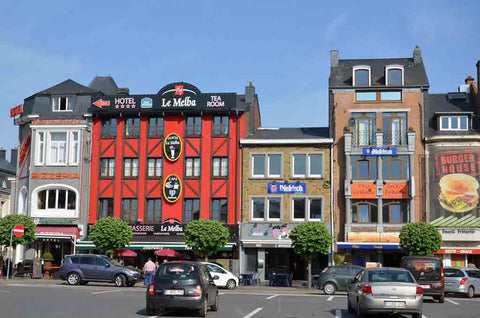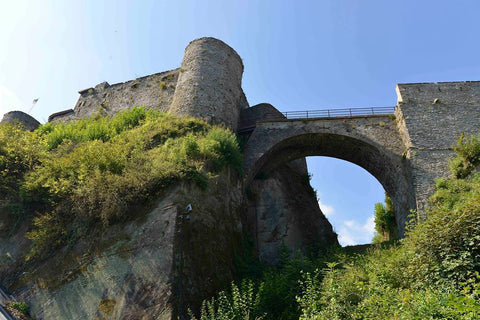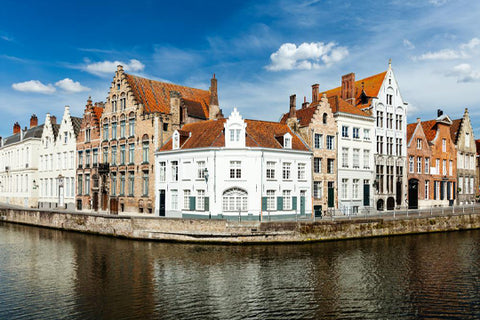- No products in the cart.
Poperinge

Poperinge isn't a town to hide its pride and joy under a bushel. In fact its pride and joy is a bushel (of sorts). Though more a pile of cones in fact. And not of wheat, but of hops. Welcome to 'hoppe stad', the Capital of Hops in Belgium, the globally-acknowledged Kingdom of Beer.
This is a town so steeped in hop-growing and beer-making that you can smell it over the horizon, even before its spired churches have rolled into sight.
A good dose of Belgium's brewed beverages owe their hoppiness to the flat open fields surrounding this small town, which lies just short of the Channel coast, in the far north-west of the country.
And two of the most legendary names in Belgian beer call its hop-fields home: Westvleteren and St. Bernardus. Enough said, you might think.
But let's give Poperinge its full due. There's plenty else to wax lyrical about with this quintessential Flanders town. It's got the churches. It's got the quirky legends. It's got (somewhat surprisingly) a strong literary tradition. And it's even got the obligatory bizarre nickname for its inhabitants. 'Keikoppen', or cobble-heads, they're called – especially by their arch-rivals, the towns-people of Ypres. Why? Well read on, dear beer-drinker, read on..
History

It was the Franks who first coined the name for this small settlement. Or rather it was the Frankish chieftain Pupurn. He took the area for his family in 5th-century AD, settling on the river crossing here, on the then-important road linking Cassel, in France, to Aardenburg in Holland. Pupurningahem it was called – 'residence of the children of Pupurn'. A name, of course, now morphed by linguistic weathering into 'Poperinge'.
It didn't become a town proper until 1147, when the Count of Flanders granted it charter status, reflecting its growing importance as a centre of cloth-making.
With rising wealth came more churches – and an intensified rivalry with the not-so-friendly neighbours in Ypres. Because Ypres, too, was making a name for itself in the cloth business. And in 1322, the Ypres townspeople persuaded the Count of Flanders, Louis de Nevers, to proclaim an edict – only Ypres could make cloth in his realm.
Not surprisingly the people of Poperinge weren't having any of that, and promptly revolted against the Count. It was the first of many run-ins between Poperinge and its nobles, and led to direct conflict between the men of Ypres and the Poperingians – or keikoppen as the Ypres militia now came to call them. Sadly that combination of stubborness and geographic bad luck (lying on the fault-line between the big powers of the day) led to long centuries of strife for the keikoppen.
The town was clobbered first by the French in 1382, and then again by the English in 1436, as part of the simmering Hundred Years War between the two nations. The 16th-century wasn't much better for Poperinge, with two devastating fires, and a Protestant uprising in 1566. The town was wrecked, as was its economy. It only really recovered when the locals planted some hop vines, and started building up a reputation for growing the finest hop-heads in the land. History then quietened down a bit for Poperinge – until the fateful year of 1914.
Popping back to 'Pop'

It might not have seemed so the time, but Poperinge was one of the more fortunate towns, when the First World War stormed across Belgium. The German advance was stopped well short of the town, near Ypres. So while the rest of Belgium was occupied – or pounded into rubble like poor Ypres – Poperinge remained free of the Germans. And it was just far back enough to avoid the worst of the devastation.
It became the rearguard stopping-off point for British troops, on their way to and from the front-line. They rechristened it 'Pop', and set up their hospitals, billets and clubs here. That connection to the British remains to this day, with buildings like the Talbot House kept open as living museums.
More grimly, those who suffered at the harsh hands of military justice – soldiers who broke down and were unable to return to front-line, and therefore promptly executed as deserters – are not forgotten either.
The death cells and execution posts of 'Pop' are preserved, as reminders of the brutality of war. The town's surroundings are also marked by numerous military cemeteries for the British, Australian, Canadian, French, German, US and Chinese men who died within miles of 'Pop' – in the trenches and killing fields of the First World War.
Getting There & Getting About
With no nearby airports connecting the Westhoek to the UK, air travellers will have to come into Poperinge via Brussels Airport, a hundred miles east. That's if you really want to insist on 'winging it in' over the Channel, and making an hour and a half's drive all the way back west. That seems a little unnecessary, especially when this part of the world is so close to the UK – and so well-served by the cross-Channel ferries.
The simplest way of getting to Poperinge from the Channel coast is via the E40/A16, exiting onto the E42/A25 at Dunkirk. Follow that road down until you reach Steenvoorde.
There you take the D948 (a secondary road) left, and pretty much follow your nose (though the signposts for 'Poperinge' will probably help a little too..)
Train travel is not quite so straight-forward here, but it is do-able. Take the Eurostar to Lille and then come across to Kortrijk, where you can change for Ypres and Poperinge. You can rail it in from Brussels too, once again changing at Kortrijk for Poperinge. Once here, you'll find public transport is functional, if not fantastic. So if you're more inclined towards independence at a gentle speed, the flat open countryside around here just begs to be cycled.
Accommodation
.jpg?1376650039)
Like Ypres, Poperinge has set itself up to cater for the needs of the 'Great War' battlefield tourists. It has five hotels in the centre of town, and 2 more further out – not bad for a city of less than 20,000 people. None too classy, but none too shabby either. There are also a large number of B&B's and guest-houses, both in town and out.
Perhaps the best for the beer-lover has to be the Brouwershuis in Watou. Stylish, friendly and located right next to the St. Bernardus Brouwerij – a brewer of beers on a par with St Sixtus, considering they once brewed for them under licence – this is an establishment that looks heaven-sent for the beer pilgrim, especially those wanting some intimacy with a brew-house.
A different sort of intimate experience can be had at the Talbot House, right in the centre of Poperinge town. It's a hostel, so all facilities are shared – including eating, cooking and washing up (though not the rooms).
But this isn't just any hostel. The Talbot House was the home of the 'Everyman's Club', an open house for those serving in the British Army, from privates to generals. Opened in 1915 by an army chaplain, it was fitted out with a library and a make-do chapel for any soldier to use, away from the front. Parts of this war-time refuge are preserved at Talbot House today, for visitors and guests alike to see and to ponder.
For The Love Of Beer
.jpg?1372535452)
There few towns in Belgium which can lay quite such a claim to beer-nirvana as Poperinge. It's hop central for the Belgian nation, growing a wide variety of hops in the well-drained soils of the coastal Flanders. It is home to the national hop museum, with the streets themselves paved with golden hops (or rather embossed way markers for the town's hop walk). What's more, Poperinge has one of the six Trappist beer-brewing abbeys within a hop (skip and jump) of the town centre: Abbey de St. Sixtus de Westvleteren.
Which just happens to produce the most exclusive beer on the globe (probably): the internationally recognised, and ridiculously hard-to-find, Westvletern XII, sometimes disputed 'Best Beer in the World'. Put it all together, and that's a pretty fat boast sheet.
So where to start? On arrival, many a novice rushes off to the Abbey de St. Sixtus, hoping to see the monks brewing merrily away. But they will be disappointed. The Trappist monks are nothing if not reclusive (just as their beers are nothing if not exclusive). The Abbey is not open to the public, and you can't purchase the Westvletern's from there – not unless you've managed to get a pre-arranged order in. There is, of course, the 'In de Vrede' café across the road, if you're keen to sup the Westvleteren nectar close to its source. Which has plenty to recommend it.
But if you're looking for an authentic and fully-immersive abbey brewing experience, Poperinge may struggle a bit to make you happy. Just down the road from Abbey de St. Sixtus there is the St. Bernardus Brouwerij.
They held the licence to brew the Westvleteren's for St. Sixtus for three decades, before the Trappists closed the door to off-the-premises brewing in 1992. St. Bernardus' doors are indeed now thrown wide open to the world's beer enthusiasts.
But despite the name, this is no abbey. The beers may be wonderful – having earned a bevy of superlatives of late – but the brewery itself is functional, with not a monk's habit in sight. That said, the enthusiasm of the guides, the wonderful tasting room, and a gift-set of four St. Bernadus beers go a long way towards making this a visit well worth the making.
Poperinge does have another little brewing ace under its sleeve, however. The Brouwerij Van Eecke has a fine pedigree, going back to 1862, when the Van Eecke family of brewers first set up shop in Watou.
What they have perfected here is a subtly hoppy blonde ale, the Hommelbier (7.5% ABV), which is packed full of the fruity notes of the local hops (rather than the hard-hitting fist-full of bitters you might expect). Dark gold, but with a clean light malt, it manages to be yeasty and creamy, without being cloying. Very much recommended.
Food & Gastronomy

Take the Flemish love of hearty food; mix in a good dollop of the freshly-caught fisherman's haul from the North Sea; garnish imaginatively with hops; and then wash down with plenty of the locally-brewed nectar. That recipe pretty much sums up the Poperinge approach to food, drink and life.
So it's unsurprising that this little town – sitting pretty in a sea of hops, gridded by farmland and water-ways, and tickled by the Channel coast – has come up with such a distinctive menu of local dishes.
What may be surprising, though, is that many of them are quite recent additions to the Poperinge repertoire. Many of its recipes have in fact been cooked-up to spice-up its gastronomic reputation. The keikoppen, it would seem, remain a determined and persistent bunch, when it comes to promoting their local produce. Terrine de witte ranke is a good place to start (it is an entrée after all). Taking the typically Flemish delicacy of rabbit – cooked in beer and prunes – as inspiration, the local chefs created this terrine in 1991.
The rabbit is mellowed with St-Bernardus Tripel to produce a soft sweet-sour terrine. This recipe follows an earlier chef-conspired innovation – kabeljauw aan de schreve (or 'border cod') – which was dreamt up in 1986.
This is a cod dish, cooked in a creamy sauce, and again heavily infused with beer, but this time using a local blonde ale. A more traditional dish is 'hennepot', one of the oldest of Poperinge's regional specialities.
It dates back to the Maria-Ommegang religious festival of the 16th-century (still going strong), and is a cold meat dish, mixing chicken, rabbit and veal in a gelatin-sauce. And you can't get more 'Poperinge' as an accompaniment, than hop shoots. Soft and tender, with an earthy bitterness, they've been compared to asparagus, and are found freshening up many of these local dishes. Away from the starters and mains, Poperinge has done well on the desert front too. Mazarinetaart is a wonderfully light sponge cake, named after its creator – Cardinal Jules Mazarin.
Best served drenched in a hot, buttery cinnamon sauce, it becomes transformed into a sticky, doughy sweet-meal. Superb washed down with a cup of hot black coffee.
But you can't get away from the hops for long in Poperinge – even when it comes to the sweet stuff. Poperingse hommelknopjes are little knobs of chocolate, especially flavoured with beer and hops, all to rather good effect. And there's even a jam made from tender hop shoots – 'houblonesse' – which is more nutty than sweet, with a lovely, velvety texture.
Shopping & Markets
You might not think that people would not come to rural Poperinge to shop. And you'd be right. They come to the Grote Markt to amble, to sniff, to bargain-hunt, to chat and to sip coffee. 'Shopping' doesn't really do its Friday market justice. It's a great opportunity to see the both locals and local produce at their best. And also to peruse the multitude of ways the locals have worked the hop plant into their foods, and into their lives.
Sightseeing & Culture

Of course, the other place to get a dose of hop madness is at the town's Hop Museum, housed in the Municipal Scales House on Gasthuisstraat. This is where hops used to be bought, to be sniffed, weighed, sorted and stored, before being shipped off to the nation's breweries.
The exhibits were updated recently, and they now present the story of local hop growing – past, present and future – through an array of audiovisuals treats, scale models and historic documents. With plenty of hops for the smelling and beers for the selling), naturally: seventh heaven.
The town has a strong artistic heritage, both in literature and in sculpture. This can be seen by the large number of statues scattered around the town. Inevitably the biggest (though not the best) has to be the giant hop bud, brooding on a roundabout at the entrance to town. More interesting is the recently installed Statue Ghybe, which satirises Poperinge's long-standing 'cloth wars' with Ypres, Ghent and Brugge (Bruges).
Those three adversarial cities (boo, hiss..) are represented by a donkey, with the mythical fool – Meester Ghybe – riding it back-to-front, in an obviously fruitless attempt to crush the stubborn Poperinge spirit. There are more statuesque references to that ancient feud too (maybe the Poperingians are still a little bitter about it .. pun fully intended).
A giant boulder in the centre of town – the Keimonument – is said to represents a river cobble stone, with water spilling out the top, and down its sides. It is, naturally, a play on the local people's nickname, given to them by their enemies and one the cobble-headed keikoppen have fully embraced.
Poperinge also has the field of religious artistic merit well-covered. Its somewhat squatly-spired church of Sint-Bertinuskerk was so venerated that, when war knocked it into rubble, in 1677, the stubborn townspeople refused to let the rubble lie still. They rebuilt it, so you can still enjoy its beauty today – and hear the clear peals of its Paccar clarion tower bells.
Activities & Entertainment

The most exciting event in Poperinge's calendar is actually only scribbled on one in three of them. That's the bad news. The good news is that its triennial hop & beer festival, next held in September 2014, is getting closer every day. There's the crowning of the hop queen, an extravagant parade through town, lots of music and even more drinking of beer. The keikoppen like to think of it (somewhat modestly) as Belgium's equivalent of the Munich Beer Festival.
The literary side of Poperinge – or more correctly the nearby village of Watou – comes out with the sun, in the Summer of Poetry, held there every year. The beat of poetry apparently runs strong in the area.
As well as Poperinge being an oft-mentioned reference in poems – for poets from Chaucer to Skelton to W.E.E. Ross – Poperinge and its villages were apparently a hotbed of Latin poets in the 16th and 17th-centuries. That playfulness with words continues to this day. Another surprising facet to Poperinge's many-sided cultural outlook is the 500-year old religious festival of Maria Omegang. It is held every July, and celebrates a very medieval miracle – the rising, from the dead of a stillborn baby.
It was attributed to the benign influence of a statue of the Virgin Mary, back in 1479. The pageant, its religious fervour and some general merry-making still carry on in the town to this day.
The procession on the 7th of July involves an elaborate statue of the Virgin Mary, lots of floats and a host of the towns-people dressed in medieval costume. This is one religious spectacle that's well worth being a spectator of.
But if you want to leave all that culture behind, and get a little more physical, the wide open countryside around Poperinge beckons. It's just waiting to be cycled, jogged or ambled over. Not that history, myth and legend will give you a rest for long.





